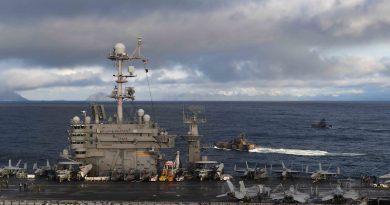U.S. Coast Guard to conduct its first-ever oil-spill test in Arctic
 With Royal Dutch Shell possibly on the eve of exploring for oil off Alaska’s Arctic coasts — and other companies waiting in the wings — the U.S. Coast Guard plans its first-ever oil-spill response drill in the fragile region next week.
With Royal Dutch Shell possibly on the eve of exploring for oil off Alaska’s Arctic coasts — and other companies waiting in the wings — the U.S. Coast Guard plans its first-ever oil-spill response drill in the fragile region next week.
The exercise will be part of the agency’s effort to beef up its presence in the largely untouched Arctic Ocean, as ship traffic rises due in part to increased industrial interests in potential undersea riches.
The guardian of the nation’s high seas recently stationed two MH-60 Jayhawk helicopters and associated personnel in Barrow, a city of 4,200 where polar bears saunter ashore in search of food and Eskimo whalers in small boats kill bowhead whales as large as semi-trucks.
The choppers bring the Coast Guard 900 miles closer to the region, said Petty officer David Mosley, a Coast Guard spokesman. That’s the distance to the nearest Coast Guard base, on Kodiak Island in southern Alaska. The helicopters will be available to help with rescues of any stripe, whether that’s plucking dying passengers from adventure-tourism ships or snagging whalers trapped on breakaway sheets of ice.
Part of the Coast Guard’s new presence also includes offering help in the event of an oil spill, if needed, Mosley said.
Summer drilling
Early next month, Shell hopes to become the first major oil company to drill exploratory wells the U.S. Arctic waters in more than a decade, though questions remain about whether it will have the permission or time needed to operate.
This summer, Shell would like to drill up to three wells in the Chukchi Sea 70 miles off northwest Alaska and up to two wells in the Beaufort Sea about 20 miles off northeast Alaska.
Other companies, such as ConocoPhillips and Norway’s Statoil, that hold leases to explore for oil in Alaska’s Arctic waters are watching to see what Shell finds this summer.
If there’s an oil spill — considered an improbable event in part because of relatively low well pressures in the shallow Arctic Ocean — the cleanup responsibility would fall on the oil company’s shoulders, Mosley said.
Shell has said it will be ready to stop a major spill or clean one up if it happens. But if the company needs help, as BP did when Coast Guard ships helped mop up its Gulf of Mexico spill in 2010, the Coast Guard again would play a crucial role.
Skimmer test
That’s where next week’s training could be critical, said Mosley. The drill is set for a three-day stretch early next week, weather depending. It will be a fairly simple one, involving the 225-foot buoy tender dubbed the Hickory, a single skimmer and some boom. In the event of a real spill, other Coast Guard ships could also be moved to Barrow to help.
The Coast Guard wants to see how the skimmer, which works like a floating vacuum to suck oil into tanks, performs in the Arctic Ocean’s cold water.
The test, which might begin next Monday or Tuesday, will be conducted independent of Shell, said Mosley. On board will be officials from the U.S. Navy, the Department of Defense, and other agencies, said Mosley.
“This is a test of our equipment in area, and has nothing to do with Shell,” he said. “While the equipment has been tested in many waters and environments, it has not been tested off the North Slope. This will be the first time it’s been deployed up there.”
The state asked to attend but the tender didn’t have enough bunk space, said Gary Folley, head of the Alaska’s oil spill prevention and response division.
Media likely to view test
The exercise won’t involve oil because federal law restricts it. But sailors on the Hickory will go through the motions as if oil were there. That includes deploying boom — long stretches of floats that can look like huge sausage links. The boom will be positioned into a U-shape for collecting the imaginary oil. The skimmer will be positioned at the bottom of the U where oil would concentrate.
News media will likely be invited to fly to Barrow on a C-130 and view the test, said Mosley.
“We’ll definitely cover it (and publicize it) with video and photo,” he said.
Will the test involve ice? Mosley didn’t know.
But publicizing the results of the drill will help it stand out from past tests. The conservation group Oceana said earlier this year that it had to use the Freedom of Information Act just to get footage from the state of a failed spill exercise in broken ice in 2000. In that exercise, the booms struggle to stay in place as drifting ice boulders power against them.
Conservationists used the video to support their claims that cleaning oil from ice will be impossible. Other proof showing oil spill response equipment working in U.S. Arctic waters doesn’t exist, said Chris Krenz, Arctic program manager manager.
Regular spill drills
But such tests have taken place off Prudhoe Bay, said Ron Hocking, operations manager with Alaska Clean Seas. That’s the industry-funded cooperative trained to respond to oil spills in waters off the North Slope, mostly in the near-shore area. Shell is a member and would draw on the company’s mini-barges, skimmers, booms and equipment if a clean up is needed, Hocking said.
Clean Seas holds regular spill drills throughout the summer in the waters off Prudhoe Bay, and usually organizes a larger annual training with state and federal officials involved to help set goals and review the effort.
There’s been a lot learned since 2000 about managing ice in spill exercises, which happens when wind and current push frozen debris toward the drill area, he said.
“A dozen years ago, we had large barges, enormous booms openings, no way to avoid ice in a lot of respects,” Hocking said.
These days, the cooperative has more nimble mini-barges in its tool kit. It’s also more adept at ice management, having learned that boats of nearly any size can nose away ice chunks before they get near a boom.
“We’ve made advances every year in how we respond,” he said.
Would it be possible to see footage or reports showing drills in broken ice?
“I’ll have to defer that to our general manager,” said Hocking, who wasn’t available Monday. The reports are “not top secret, but we do a lot of that for the oil companies,” he said.
Contact Alex DeMarban at alex(at)alaskadispatch.com
For more stories from Alaska Dispatch, click here



